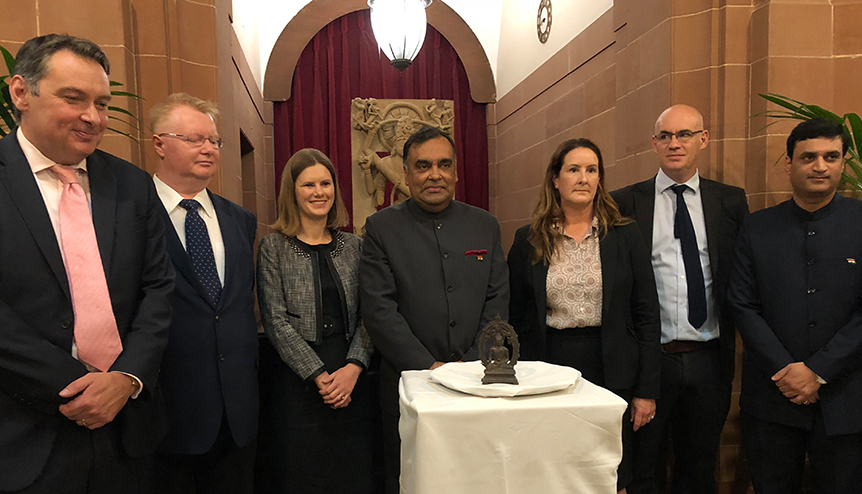Stolen 12th century Indian Buddha statue found in London

A bronze Buddha statue of the 12th century stolen from an Indian museum 57 years ago has surfaced in London and is now returning to the country.
The bronze statue with silver inlay is one of 14 statues stolen in 1961 from the Archaeological Survey of India (ASI) site museum in Nalanda and changed several hands over the years before surfacing at a London auction.
Once the dealer and the owner were made aware the sculpture was the same one that had been stolen from India, the Metropolitan Police said they cooperated fully with the Met’s Art and Antiques Unit and agreed for the piece to be returned to India.
“I am delighted to return this piece of history. This is an excellent example of the results that can come with close cooperation between law enforcement, trade and scholars,” said Met Police Detective Chief Inspector Sheila Stewart, who was accompanied by officials from the UK’s Department for Digital, Culture, Media and Sport at the handover ceremony.
“Although this was stolen over 50 years ago, this did not prevent the piece being recognised and the credit must go to the eagle eye informants who made us aware that the missing piece had been located after so many years,” she said.
The statue was identified at a trade fair in March this year by Lynda Albertson of the Association for Research into Crimes Against Art (ARCA) and Vijay Kumar from the India Pride Project, who then alerted the police. Sinha described the return of the “priceless Buddha” as a “wonderful gesture” and a particular honour given his own roots in Bihar.
“I hope it will now go back to where it originally belongs… On our Independence Day, it [return of the statue] highlights the multi-faceted cooperation between our two countries,” he said, after a Tricolour-hoisting ceremony to mark India’s 72nd Independence Day at the Indian High Commission in London.
Detective Constable Sophie Hayes, of the Met’s Art and Antique Unit, said it had been established that there was no criminality by the current owner or the dealer who had been offering the stolen statue for sale.
“Indeed, from the outset, they have cooperated fully with the police to resolve this matter and they have made the decision to return the sculpture via the police,” Hayes said. “We are delighted to be able to facilitate the return of this important piece of cultural heritage to India,” she added.
The Art and antique Unit was founded 50 years ago and are one of the oldest specialist units in the Metropolitan Police Service. The unit prides itself on a “long history of reuniting owners with their stolen property”.
Michael Ellis, UK Minister for Arts, Heritage and Tourism, said: “As we celebrate India’s Independence Day, I am proud to highlight the latest example of the UK’s cultural diplomacy in action.
Thanks to the work of the Metropolitan Police’s Arts and Antiques Unit, we are one of the first countries to recover one of the 14 elusive Buddha statues stolen from Nalanda nearly 60 years ago.
“This underlines how law enforcement and the London art market are working hand in hand to deliver positive cultural diplomacy to the world.”
Valuable artefacts have been stolen from India over the centuries by colonial plunderers. However, the latest case involved a notorious smuggling ring. The model of a seated Indian God Vishnu was one of 14 statues taken from an archaeological museum in Nalanda, eastern India.
It is believed to have changed hands several times before it was unsuspectingly offered for sale and both the owner and the dealer agreed for it to be returned to India, for it to return to the place it was snatched from.
The recovered relic is a delicate artwork that depicts Buddha in the Bhumisparsha mudra —seated, with his right hand resting over his right knee, reaching toward the ground and touching his lotus throne.
The gesture symbolises the moment that Buddha summoned the earth as a witness to his enlightenment, and it is commonly represented in Buddhist iconography.
It was created using the specialist “lost wax” technique, which involves a wax model being made which can be used only once, as the wax melts away when the molten bronze is poured into the mould. This makes the statue an extremely unique piece of art and part of India’s ancient tradition.
The identity of the dealer and fair have been kept under wraps.





